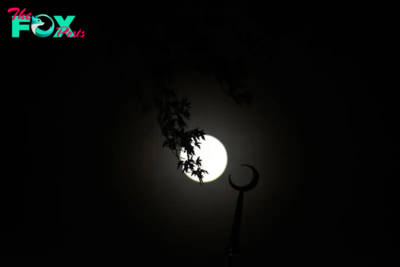Science
The smallest full moon of 2024 rises this weekend. Here's how to see the 'Snow Moon' at its best.
February's full moon, the second of 2024, will rise in a blaze of color and light this weekend — but don't expect a giant orb in the twilight sky. Thanks to orbital mechanics, the "Snow Moon" will be the smallest of the year as it rises during dusk on Saturday (Feb. 24).
The exact opposite of a supermoon, this Snow Moon will turn full when our natural satellite's orbit is close to its farthest point from Earth in its slightly elliptical monthly orbit.
Despite its smaller size, the Snow Moon, also known as the Hungry Moon, Storm Moon, Wolf Moon and Candles Moon, according to NASA, promises a breathtaking display. Its appearance will signal the start of the Lantern Festival, also called Shang Yuan or the Yuan Xiao Jie, which is part of the Chinese New Year celebrations.
Although it will technically turn full during the day in North America — at 7:30 a.m. EST — the best time to see it will be at moonrise later that day. You can find the exact time for your location using a moonrise and moonset calculator.
Related: Undiscovered 'minimoons' may orbit Earth. Could they help us become an interplanetary species?
Look for the Snow Moon rising in the east just after sunset on Saturday, when it will glow a deep orange color due to Earth's atmosphere. For the best view, find a high spot facing east with a clear horizon. Unaided eyes are ideal for watching a full moonrise, but binoculars will enable you to see craters and other features on the lunar surface. The moon will also appear bright and full on Friday and Sunday, as well.
—April 8 total solar eclipse: The best places to stargaze near the path of totality
—Intuitive Machines moon lander beams home stunning photos of Earth from space
—China eyes May 2024 launch for 1st-ever lunar sample-return mission to far side of the moon
After the "Snow Moon," the following full moon will be the "Worm Moon" on March 25, which will drift into Earth's shadow and cause a slight penumbral lunar eclipse. That will put the moon in position to cause a total solar eclipse two weeks later on April 8, which will be best seen within a narrow 115-mile-wide (185 kilometers) path of totality stretching across northwest Mexico, 15 U.S. states and six Canadian provinces.
-

 Science1d ago
Science1d agoHow to See the ‘Beaver’ Supermoon—the last of 2024
-

 Science5d ago
Science5d agoInside Capitol Hill’s Latest UFO Hearings
-

 Science5d ago
Science5d agoYou Won’t Want to Miss the Leonid Meteor Shower. Here’s How and When You Can See It
-

 Science6d ago
Science6d agoHere’s What Trump’s Win Means for NASA
-

 Science1w ago
Science1w agoWhy Risky Wildfire Zones Have Been Increasing Around the World
-

 Science1w ago
Science1w agoIt’s Time to Redefine What a Megafire Is in the Climate Change Era
-

 Science1w ago
Science1w ago4 Astronauts Return to Earth After Being Delayed by Boeing’s Capsule Trouble and Hurricane Milton
-

 Science1w ago
Science1w agoThe Elegance and Awkwardness of NASA’s New Moon Suit, Designed by Axiom and Prada



























